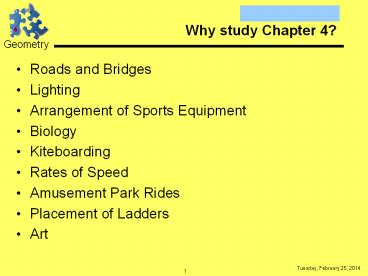Why study Chapter 4? - PowerPoint PPT Presentation
1 / 19
Title:
Why study Chapter 4?
Description:
Detour Proof: A proof involving more than one pair of triangles. ... Procedure for Detour Proofs: ... Detours and Midpoints. Midpoint formula!! M = (xm, ym) ... – PowerPoint PPT presentation
Number of Views:31
Avg rating:3.0/5.0
Title: Why study Chapter 4?
1
Why study Chapter 4?
- Roads and Bridges
- Lighting
- Arrangement of Sports Equipment
- Biology
- Kiteboarding
- Rates of Speed
- Amusement Park Rides
- Placement of Ladders
- Art
2
- Crossing Streams
- Picnic tables
- Platforms
- Marketing
- Archaeology
- Distribution
- Engineering
3
Section 4.1More Proofs and Midpoints
F
Given
B
B
A
C
D
E
Prove
G
- Detour Proof A proof involving more than one
pair of triangles. A two part proof, just like
youve been doing!
4
Section 4.1
- Procedure for Detour Proofs
- Determine which triangles you must prove to be
congruent to reach the required conclusion - Attempt to prove these triangles congruent, if
you dont have enough info, proceed to step 3. - Identify the parts of the triangle that you are
missing. - Find another pair of triangles that
- You can prove congruent
- Contain the pair of parts needed
- Prove the triangles in Step 4 congruent
- Use CPCTC and prove the triangles in Step 1
congruent
5
Section 4.1Detours and Midpoints
Midpoint formula!! M (xm, ym) ?
6
Section 4.2Missing Diagrams
- if .givens, then.prove
- 1. If two altitudes of a triangle are
congruent, - then the triangle is isosceles
- 2. The medians of a triangle are
congruent if - the triangle is equilateral
- No if, then
- Givens usually in the beginning of the
statement - 1. The altitude to the base of an isosceles
- triangle bisects the vertex angle
7
Section 4.3A Right-Angle Theorem
- Theorem If two angles are both supplementary
and congruent, then they are right angles
D
2
1
A
B
C
8
Section 4.4The Equidistance Theorems
- Distance The distance between two objects is
the length of the shortest path between them. - Postulate A line segment is the shortest path
between two points.
9
Section 4.4The Equidistance Theorems
- Perpendicular Bisector the line that bisects
and is perpendicular to a segment. - Theorem If 2 points are each equidistant from
the endpoints of a segment, then the two points
determine the perpendicular bisector of the
segment. - Theorem If a point is on the perpendicular
bisector of a segment, then it is equidistant
from the endpoints of that segment
A
10
Section 4.5Intro to Parallel Lines
- Plane A surface such that if any 2 points on
the surface are connected by a line, all points
of the line are also on the surface - Coplanar If points, lines, segments, and so
forth, lie in the same plane. - Noncoplanar If points, lines, segments do NOT
lie on the same plane
11
Section 4.5Intro to Parallel Lines
- Transversal A line that intersects two coplanar
lines in two distinct points.
Interior Region
12
Section 4.5Intro to Parallel Lines
- Alternate Interior angles A pair of angles
formed by two lines in a transversal. The
angles must - Lie in the interior of the figure
- Lie on alternate sides of the transversal
- Have different vertices
1 2 3 4
5 6 7 8
13
Section 4.5Intro to Parallel Lines
- Alternate Exterior angles A pair of angles
formed by two lines in a transversal. The
angles must - Lie in the exterior of the figure
- Lie on alternate sides of the transversal
- Have different vertices
1 2 3 4
5 6 7 8
14
Section 4.5Intro to Parallel Lines
- Corresponding angles A pair of angles formed by
two lines in a transversal. The angles must - One angle must lie on the interior and the other
on the exterior - Lie on same sides of the transversal
- Have different vertices
1 2 3 4
5 6 7 8
15
Section 4.5Intro to Parallel Lines
16
Section 4.5Intro to Parallel Lines
- Parallel Lines Two coplanar lines that do not
intersect
17
Section 4.6Slope
- Slope The slope m of a nonvertical line,
segment, or ray containing and
is defined by the formula
- What is the slope of a horizontal line?
- What is the slope of a vertical line?
18
Section 4.6Slope
19
Section 4.6Slope
- 4 More Theorems!!!!
- If two nonvertical lines are parallel, then their
slopes are equal. - If the slopes of two nonvertical lines are equal,
then the lines are parallel (the converse) - If two lines are perpendicular and neither is
vertical, each lines slope is the opposite
reciprocal of the others. - If a lines slope is the opposite reciprocal of
another lines slope, then two lines are
perpendicular (the converse)































